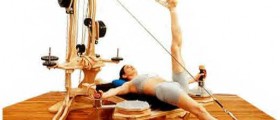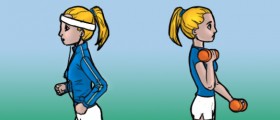Dancing is not only an activity that is fun and a great way to improve and revitalize one’s social life, decrease stress, and increase relaxation, but it is also a great form of exercise.
It is no surprise that many gyms and health centers now offer dance classes along with regular aerobics.
One of the most healthy and intense forms of dance is ballet. The best part is that it comes in many forms and styles and can be tailored to fit both the health demands and requirements and interests of all individuals.

Though ballet often looks effortless when performed by professionals, a lot of training and strength is needed, which is what makes it a complete full-body workout.
Why is Ballet Healthy
Studies have proven that ballet dancing can help decrease the risks of high blood pressure, diabetes, high cholesterol, heart disease, and degenerative bone loss.
The main benefit of ballet is that it increases body flexibility, and the range of a person’s motion, and significantly improves coordination. Many people that would not be expected to dance ballet, namely football players and other professional athletes, often resort to this style of dancing as training for improving coordination and making them more graceful on the field.
There is no denying that ballet works out the entire body. It can be especially beneficial for middle-aged people who are aging and losing their mobility, which is usually a result of not remaining active enough in their lives physically.
Though it does not appear to be so at first glance, ballet is, in reality, an excellent form of strength training and is great for people who do not like regular strength workouts that involve weightlifting.
Since the entire body is used while dancing ballet, the person is building muscle while dancing and also toning his or her body and decreasing excess body fat.
Most people who suffer from back pain can blame their lack of strong abdominal muscles, which ballet helps to strengthen as well. These muscles are crucial in supporting the spinal column. By strengthening these core muscles, a person's posture will improve, which will in turn decrease both the intensity and frequency of back pain.
Aside from the obvious physical benefits of ballet, there are also psychological and emotional benefits like an increase in social interaction at the classes, a reduction of stress levels, and a newly found sense of self-confidence, which comes as one’s appearance and health improve.
Not only does ballet help reduce everyday problems such as stress, but it has been shown to decrease the risk of dementia, senility, and Alzheimer’s disease as well.
- A structured search strategy was conducted using the databases of PubMed, MEDLINE, Web of science, PsycARTICLES, and Social Science database. This review used the Preferred Reporting Items for Systematic Reviews and Meta-Analyses (PRISMA) guidelines for systematic reviews. Studies that were published in the past 20 years were considered for inclusion. All written publications were searched for in English, and all articles included in this review were peer reviewed full papers.
- Publications were identified for inclusion using the MeSH terms Children OR Teenager OR Adolescent OR Schoolchildren OR Student AND Dance OR Dancing OR Ballroom-dance OR Sport-dance OR Ballet OR Jazz OR Folk-dance OR Hip-Pop OR Square-dance OR Dance-movement-therapy OR Dance-effectiveness OR Dance-interventions. Additionally, other review or systematic review articles were used as guidelines to source articles that matched the inclusion criteria.
- Traditional neuromuscular training lacks fun, creativity, and movement exploration. As an aesthetic movement art form, dance also has a positive psychotherapeutic impact, which may improve the intelligence and dual tasking of children with Down syndrome. In addition, children express their creativity and emotions such as joy, fun and happiness in the process of practicing and participating in dance, which provides children with body awareness, enthusiasm, and confidence.
- Ballet and Laban’s dance have been demonstrated to improve balance, rhythm, and autonomous control in children who were Down syndrome patients. A previous study used traditional Indian dance as an intervention investigating outcomes in 36 children with Down syndrome. Traditional Indian dance appeared to be beneficial for improving locomotor skills and balance capacity in children with Down syndrome.
- www.betterhealth.vic.gov.au/health/healthyliving/dance-health-benefits
- www.health.harvard.edu/blog/lets-dance-rhythmic-motion-can-improve-your-health-201604219468
- Photo courtesy of dalbera by Wikimedia Commons: commons.wikimedia.org/wiki/File:Pas_de_deux_du_Corsaire_Ballet_national_de_Cuba_(Grand_Palais)_(989747896).jpg

















Your thoughts on this
Loading...